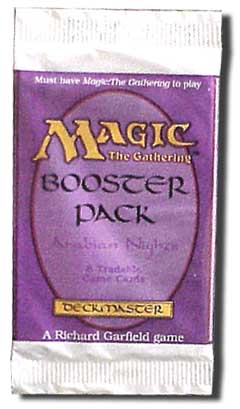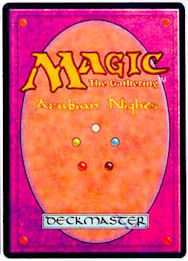Arabian Nights: Difference between revisions
>Hunterofsalvation |
>Hunterofsalvation |
||
| Line 27: | Line 27: | ||
{{DailyRef|mtgcom/arcana/155|Arabian rarities|[[Magic Arcana]]|August 7, 2002}}</ref> ''Arabian Nights'' was designed by [[Richard Garfield]] <ref>{{DailyRef|mtgcom/feature/78|The Making of ''Arabian Nights''|[[Richard Garfield]]|August 05, 2002}}</ref> and co-developed by [[Joel Mick]] and [[Skaff Elias]]. <ref>{{DailyRef|mtgcom/daily/rb32|Better Late Than Never|[[Skaff Elias]]|August 09, 2002}}</ref> | {{DailyRef|mtgcom/arcana/155|Arabian rarities|[[Magic Arcana]]|August 7, 2002}}</ref> ''Arabian Nights'' was designed by [[Richard Garfield]] <ref>{{DailyRef|mtgcom/feature/78|The Making of ''Arabian Nights''|[[Richard Garfield]]|August 05, 2002}}</ref> and co-developed by [[Joel Mick]] and [[Skaff Elias]]. <ref>{{DailyRef|mtgcom/daily/rb32|Better Late Than Never|[[Skaff Elias]]|August 09, 2002}}</ref> | ||
===Marketing=== | ===Marketing=== | ||
[[File:Magic card back 2.jpg|right]] | [[File:Magic card back 2.jpg|right|the rejected card back for ''Arabian Nights'']] | ||
The print run was announced by Wizards to be 5 million cards. Cards were available from late December 1993 until late January 1994. They were sold in [[booster pack]]s of eight cards which included six [[common]]s and two [[uncommon]]s. Booster boxes contained 60 booster packs. ''Arabian Nights'' booster boxes are now extremely rare and cost tens of thousands of dollars. The summer after the release, while ''[[The Dark]]'' debuted, ''Arabian Nights'' booster packs were allready selling for five dollars compared to the original price of only $1.50. | The print run was announced by Wizards to be 5 million cards. Cards were available from late December 1993 until late January 1994. They were sold in [[booster pack]]s of eight cards which included six [[common]]s and two [[uncommon]]s. Booster boxes contained 60 booster packs. ''Arabian Nights'' booster boxes are now extremely rare and cost tens of thousands of dollars. The summer after the release, while ''[[The Dark]]'' debuted, ''Arabian Nights'' booster packs were allready selling for five dollars compared to the original price of only $1.50. | ||
Revision as of 09:14, 7 March 2014
- For other uses, see Arabian Nights (disambiguation).
| Arabian Nights | |
|---|---|
| Set Information | |
| Set symbol | |
| Themes and mechanics |
Non-mana producing lands, meta-game effects, coin-flip effects |
| Keywords/ability words | None new |
| Set size | 78 (26 Common 52 Uncommon) |
| Expansion code | ARN |

Arabian Nights is the first Magic expansion and was released in December 1993. [1] It is not considered part of any block.
Set details
Arabian Nights was printed on sheets of 121 cards. The set's rarity breakdown is: 26 commons (1@C11, 9@C5, 16@C4) and 52 uncommons (1@C1, 1@U4, 17@U3, 33@U2). Due to printing errors, 14 common cards had variants which caused the mana symbol to be discolored. This makes it so collectors view this as as 92 card set. [2] [3] Arabian Nights was designed by Richard Garfield [4] and co-developed by Joel Mick and Skaff Elias. [5]
Marketing

The print run was announced by Wizards to be 5 million cards. Cards were available from late December 1993 until late January 1994. They were sold in booster packs of eight cards which included six commons and two uncommons. Booster boxes contained 60 booster packs. Arabian Nights booster boxes are now extremely rare and cost tens of thousands of dollars. The summer after the release, while The Dark debuted, Arabian Nights booster packs were allready selling for five dollars compared to the original price of only $1.50.
Originally it was planned to feature a different card back for Arabian Nights and each following expansion but this proved to be infeasible as people would be able to tell which card they would probably draw next depending on the ratio of cards from each expansion in their decks. [6]
Setting and storylines
The storyline of Arabian Nights was unique in Magic (up to the release of Portal: Three Kingdoms) in being the only set to be based on a real-world setting instead of one of the planes in the Magic multiverse. Inspired by the comic Sandman #50, titled Ramadan, and based on The Book of One Thousand and One Nights, Richard Garfield created the set with not only a Arabian setting, but also added many characters, locations and events that came directly from the novel. [7]
As a result of the real-world references and stark difference from the world of Dominaria, Arabian Nights was to take place in the plane of Rabiah, which once had been ruled by the Djinni. After the Djinni had weakened themselves in the Spirit War known as The Jihad, humans became the main race of Rabiah. Characters like Aladdin, Ali Baba and King Suleiman had lived long ago. After that the plane was reproduced a thousand times in the Thousand-fold Refraction of Rabiah to keep the 1001 Nights parallel going.
Several stories have been released that took place on Rabiah. Foremost is the story of the planeswalker Taysir, chronicled in the comics released by ARMADA. There were also two short stories; one dealing with the history of the City of Brass, the Brass Men and the planeswalker Fatima, while the other told the origins of the Serendib Efreets, Bird Maidens and Flying Men.
Creature types
Most of the creature types used in Arabian Nights were new, and many are unique. Early expansions had creature types only for flavor reasons, resulting in many unusual types.
The following creature types are introduced in this expansion: Aladdin (later changed to Rogue), Ali Baba (later changed to Rogue), Ali from Cairo (later changed to Human), Ape, Asp (later changed to Snake), Camel, Cavalry (later changed to Knight), Dandân (later changed to Fish), Devil, Efreet, Egg (later changed to Bird), El Hajjâj (later changed to Wizard), Elephant, Flying Men (later changed to Human), Guardian (later changed to Beast), Island Fish (later changed to Fish), Jackal (later changed to Hound), King (later changed to Human), Leper (later changed to Human), Bird Maiden (later changed to Human Bird), Marid (later changed to Djinn), Nomad, Raider (later changed to Warrior), Sindbad (later changed to Human), Singing Tree (later changed to Plant), Smith (later changed to Human), Sorceress (later changed to Wizard), Tortoise (later changed to Turtle), and Witch (later changed to Wizard).
The following creature types are used in this expansion but also appear in previous sets: Djinn, Ghoul (later changed to Zombie), Ogre, Ship (later changed to Human) and Wolf.
Notable cards
- Ali from Cairo was once considered powerful enough to be on the Restricted List, but has since been removed because there are many ways to deal with it.
- Bazaar of Baghdad is amongst the most powerful lands ever to be printed and one of the defining cards of the Vintage format.
- City of Brass is the first land to produce any color of mana, and is still good enough to see use today. It was printed in Chronicles and every core set from 5th Edition through Eighth Edition.
- Desert is the first common nonbasic land.
- Erhnam Djinn was once a powerful green creature and was central to the "Erhnamgeddon" decks that used Armageddon to negate the drawback of the "Ernie" and leave an opponent helpless to its attack.
- Juzam Djinn was once considered the most powerful creature in the game.
- Kird Ape is still one of the most powerful "one-drop" creatures to date. Many Zoo decks still run it along side Tarmogoyf and other under-costed large creatures. Kird Ape was reprinted in Ninth Edition, but was voted out of Tenth Edition in favor of Mogg Fanatic.
- Library of Alexandria is arguably one of the most powerful card drawing cards in the game.
- Serendib Efreet is the best purely aggressive monoblue creature ever printed. Used in the Legacy deck Faerie Stompy.
- Shahrazad is the only card banned in Vintage that doesn't require ante (Amulet of Quoz) or manual card manipulation (Chaos Orb). It was banned in both Legacy and Vintage tournaments on September 20, 2008 due to time restrictions in tournaments.
Cycles
Arabian Nights has no true five-color cycles. There are four Efreet and four Djinn cards, however, with one for each color except White. According to Richard Garfield, efreet and djinni "did not seem to belong in White — while not always evil, they were never good."
Trivia
References=
- ↑ Mark Rosewater (December 06, 1993). "What If week: Nights of the Round Table". magicthegathering.com. Wizards of the Coast.
- ↑ Magic Arcana (August 8, 2002). "(a) versus (b)". magicthegathering.com. Wizards of the Coast.
- ↑ Magic Arcana (August 7, 2002). "Arabian rarities". magicthegathering.com. Wizards of the Coast.
- ↑ Richard Garfield (August 05, 2002). "The Making of Arabian Nights". magicthegathering.com. Wizards of the Coast.
- ↑ Skaff Elias (August 09, 2002). "Better Late Than Never". magicthegathering.com. Wizards of the Coast.
- ↑ Magic Arcana (August 05, 2002). "The almost different back". magicthegathering.com. Wizards of the Coast.
- ↑ Michael G. Ryan (August 09, 2002). "Magic: The Naming -Arabian Nights". magicthegathering.com. Wizards of the Coast.
External links
- Arabian Nights product information page — Wizards of the Coast
- Mark Rosewater's article on Arabian Nights
- Magic Arcana (August 6, 2002). "Arabian Nights product images". magicthegathering.com. Wizards of the Coast.
- Magic Arcana (August 5, 2002). "Proposed card back for Arabian Nights". magicthegathering.com. Wizards of the Coast.
- Some scans from the Arabian Nights comic
- “The City of Brass”, a story about the creation of the City of Brass
- “The Eater of the Infinite”, a story about a Serendib Efreet